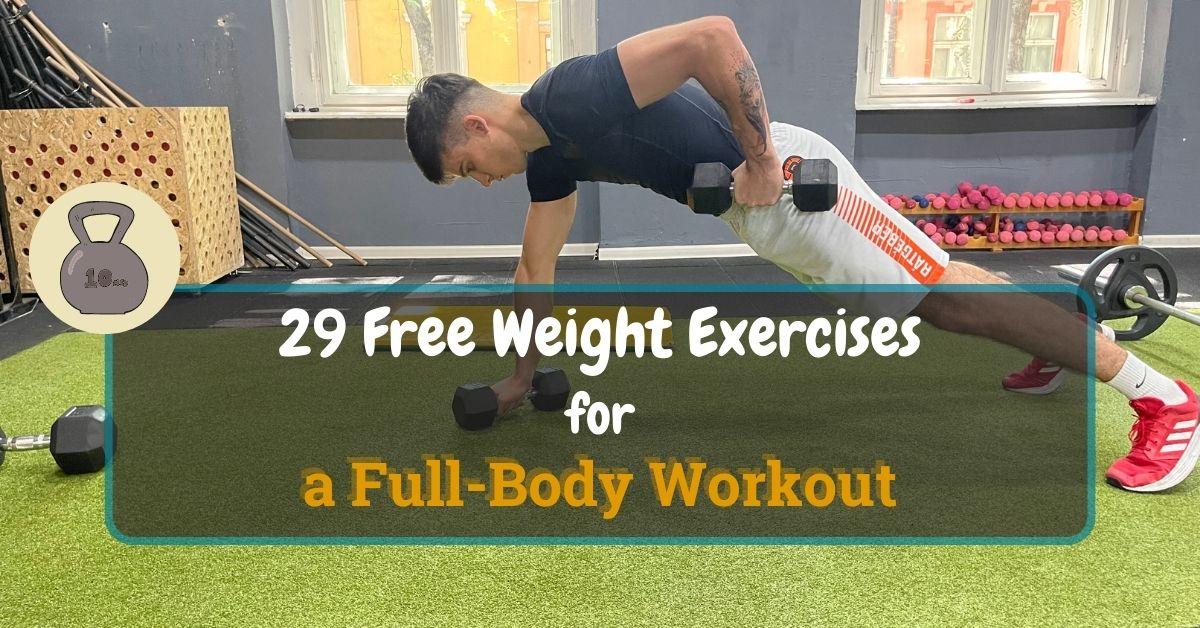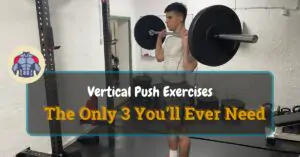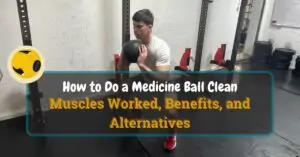Free weight exercises are considered the most functional type of workout out there since they allow for a greater range of motion, more freedom of movement, and require stabilizer muscle activation.
Table of Contents
ToggleBased on my experience as a Faculty of Sport and Physical Education student and more than 30 hours of in-depth research, I compiled the ultimate list of free weight exercises to enable you to enjoy full-body workouts.
Every exercise will cover muscles and joints worked, unique information for each specific exercise, and instructions on performing a particular exercise correctly and without injuries.
Start Building Your Dream Body Today
Ready to elevate your fitness game without falling into the trap of dull, repetitive routines that just don’t deliver? Imagine sculpting your ideal physique and boosting your health, all while still enjoying life’s pleasures, like those irresistible weekend getaways and your aunt’s legendary cheesecake. With our online fitness and nutrition coaching service, you don’t have to compromise. Dive into a personalized fitness journey that blends perfectly with your lifestyle, not against it. Book your completely free discovery consultation today, and take the first step towards a transformation that doesn’t require giving up the joys of life.

“I was skeptical about online fitness coaching, but Functional Body Savage completely changed my perspective. Vanja and Radomir’s personalized approach and attention to detail have helped me achieve goals I never thought possible. I’m stronger, more confident, and grateful for their guidance.”
Emily Thompson, San Francisco, CA
Learn More About Our Online Coaching ServiceQuick Summary
- Free weight exercises include squats, lunges, Romanian deadlifts, bench presses, overhead presses, dumbbell curls, dumbbell triceps extensions, deadlifts, flyes, shrugs, calf raises, Russian twists, and many more.
- Free weight exercises differ from machines in many things, but the most important is the range of motion, activation of stabilizer muscles, injury risk, and athletic performance.
- Free weights include kettlebells, dumbbells, barbells, medicine balls, weight plates, and similar equipment.
What Are Free Weights?
Free weights are a type of exercise equipment used for strength training and resistance exercises. Unlike machines that have a fixed range of motion, free weights are not attached to any specific apparatus or framework.
They consist of individual weights that are not mechanically connected to each other or a machine.
Common examples of free weights include dumbbells, barbells, kettlebells, and weight plates.
Free weights offer a wide range of exercises and can be used to target various muscle groups.
They provide more freedom of movement and require greater stabilization and coordination compared to machines.
Free weight exercises can be performed in different positions (standing, sitting, lying down) and allow for more natural, functional movements.
Free Weight Exercises
- Squats
- Lunges
- Romanian Deadlifts
- Dumbbell Step-Ups
- Dumbbell Reverse Lunges
- Dumbbell Goblet Squats
- Deadlifts
- Bent-Over Rows
- Dumbbell Pullovers
- Dumbbell Bent-Over Rows
- Dumbbell Renegade Rows
- Bench Press
- Dumbbell Flyes
- Dumbbell Bench Press
- Overhead Press
- Shoulder Press
- Arnold Press
- Dumbbell Lateral Raises
- Dumbbell Front Raises
- Dumbbell Reverse Flyes
- Dumbbell Shoulder Press
- Bicep Curls
- Tricep Extensions
- Dumbbell Hammer Curls
- Dumbbell/EZ Bar Skull Crushers
- Russian Twists
- Dumbbell Farmer’s Walk
- Shrugs
- Calf Raises
1. Squats
Squats are a highly effective compound exercise that targets the quadriceps, hamstrings, glutes, calves, and core muscles.
They engage the hip, knee, and ankle joints, promoting strength and stability throughout the lower body.
Squats are known for their ability to improve overall leg strength and power.
Barbell back squats, dumbbell squats, and kettlebell squats are all excellent representatives of good free weight exercises.
Instructions for Squats
- Stand with your feet shoulder-width apart, toes slightly turned out.
- Keep your chest up and your back straight throughout the movement.
- Lower your body by pushing your hips back and bending your knees.
- Descend until your thighs are parallel to the ground or as low as your flexibility allows, ensuring your knees stay in line with your toes.
- Pause briefly at the bottom, then push through your heels to return to the starting position.
- Repeat for the desired number of repetitions.
2. Lunges
Lunges primarily target the quadriceps, hamstrings, glutes, and calves. They engage the hip, knee, and ankle joints, promoting lower body strength and balance.
Lunges are a unilateral exercise, helping to address muscle imbalances and improve stability.
Free weight exercises such as dumbbell lunges, barbell lunges, or kettlebell lunges build a strong and muscular lower body.
Instructions for Lunges
- Assume a standing position with your feet flat and hip-width apart.
- Take a step forward or backward with your left leg, maintaining an upright torso.
- Lower your body until both knees are at a 90-degree angle, ensuring your left foot stays aligned with your left knee.
- Keep your back knee hovering slightly above the floor.
- Push through your front heel to return to the starting position.
- Repeat on the other side, alternating legs for each repetition.
3. Romanian Deadlifts
Romanian deadlifts primarily target the hamstrings, glutes, and lower back muscles.
They engage the hip and knee joints while focusing on hip extension and strengthening the posterior chain.
Romanian deadlifts are particularly effective for developing hamstring and glute strength.
Barbell Romanian deadlifts are a great representative of free weight exercises that will bulletproof your posterior chain muscles.
Instructions for Romanian Deadlifts
- Stand with your feet hip-width apart, holding a barbell or dumbbells in front of your thighs.
- Hinge at the hips, maintaining a slight bend in your knees and keeping your back straight.
- Lower the weight by pushing your hips back and allowing the weight to slide down your legs.
- Lower the weight until you feel a stretch in your hamstrings while maintaining a neutral spine.
- Engage your glutes and hamstrings to reverse the movement and return to the starting position.
- Repeat for the desired number of repetitions.
4. Dumbbell Step-Ups
Dumbbell step-ups are one of the best exercises with free weights that target the quadriceps, glutes, hamstrings, and calves.
They engage the hip, knee, and ankle joints while promoting unilateral strength and stability.
Step-ups are a functional exercise that mimics movements like climbing stairs.
Instructions for Dumbbell Step-Ups
- Hold a dumbbell in each hand, standing facing a bench or step.
- Place your left foot entirely on the bench, ensuring your knee is in line with your toes.
- Drive through the heel of your leading foot to lift your body onto the bench.
- Extend your hip and knee until your trailing leg is straight.
- Lower your trailing leg back down to the starting position.
- Repeat with the left leg for the desired number of repetitions before switching to the other leg.
5. Dumbbell Reverse Lunges
Dumbbell reverse lunges primarily target the quadriceps, hamstrings, glutes, and calves.
They engage the hip, knee, and ankle joints while emphasizing the glutes and hamstrings.
Reverse lunges are a variation of free weight exercises that help improve balance, coordination, and unilateral leg strength.
Instructions for Dumbbell Reverse Lunges
- Stand tall with dumbbells in each hand, arms hanging by your sides.
- Take a step backward with one leg, lowering your body until both knees are at a 90-degree angle.
- Ensure your front knee stays aligned with your ankle, and your back knee hovers slightly above the floor.
- Push through your front heel to return to the starting position.
- Repeat on the other leg, alternating legs for each repetition.
6. Dumbbell Goblet Squats
Dumbbell goblet squats target the quadriceps, hamstrings, glutes, and core muscles.
This free weight exercise engages the hip, knee, and ankle joints while challenging core stability and promoting an upright squatting posture.
Goblet squats are a great option for beginners or those who struggle with form in traditional squats.
Instructions for Goblet Squats
- Hold a dumbbell vertically against your chest, grasping it with both hands.
- Stand with your feet shoulder-width apart.
- Keep your chest up and your back straight throughout the movement.
- Lower your body by pushing your hips back and bending your knees.
- Descend until your thighs are parallel to the ground or as low as your flexibility allows, ensuring your knees stay in line with your toes.
- Pause briefly at the bottom, then push through your heels to return to the starting position.
- Repeat for the desired number of repetitions.
7. Deadlifts
Deadlifts are a compound exercise that primarily target the hamstrings, glutes, lower back, and traps.
This exercise with free weights engages the hip, knee, and ankle joints while promoting overall strength and power in the hips and lower back.
Deadlifts are known for their ability to build total body strength and improve posture.
Instructions for Deadlifts
- Stand with your feet hip-width apart, toes under the barbell.
- Bend at the hips and knees, gripping the bar with an overhand or mixed grip.
- Keep your chest up, back flat, and core engaged.
- Drive through your heels, lifting the bar off the ground, extending your hips and knees.
- Stand tall with the barbell, ensuring a neutral spine.
- Lower the barbell by hinging at the hips and bending your knees, maintaining control.
- Return the barbell to the ground, keeping your back flat and core engaged.
- Repeat for the desired number of repetitions.
8. Bent-Over Rows
Bent-over rows primarily target the upper back muscles, including the rhomboids, latissimus dorsi, and traps.
They engage the shoulder and elbow joints while promoting upper body strength and posture.
Bent-over rows are an effective exercise for developing a strong and defined back.
Free weight exercises, such as bent-over rows, are usually performed with barbells, kettlebells, or dumbbells.
IIf you want to learn the perfect dumbbell row technique, read our ultimate guide to master the form to avoid injury and maximize performance.
Instructions for Bent-Over Rows
- Stand with your feet shoulder-width apart, holding a barbell or dumbbells in front of you with an overhand grip.
- Hinge at the hips, keeping your back straight and chest up, until your torso is at a 45-degree angle.
- Engage your core and retract your shoulder blades.
- Pull the weights up toward your lower chest, squeezing your shoulder blades together.
- Lower the weights in a controlled manner, fully extending your arms.
- Repeat for the desired number of repetitions.
9. Dumbbell Pullovers
Dumbbell pullovers primarily target the muscles of the upper back, chest, and triceps.
This free weight exercise primarily engages the shoulder and elbow joints while promoting upper body strength and flexibility.
Dumbbell pullovers are a versatile exercise that can be performed on a bench or stability ball.
Instructions for Dumbbell Pullovers
- Lie on a bench or stability ball, holding a dumbbell with both hands directly over your chest.
- Keep your core engaged and maintain a slight bend in your elbows.
- Slowly lower the dumbbell backward in an arc motion until you feel a stretch in your chest and shoulders.
- Pause briefly, then use your chest and back muscles to pull the weight back up to the starting position.
- Repeat for the desired number of repetitions.
10. Dumbbell Bent-Over Rows
Dumbbell bent-over rows target the upper back muscles, including the rhomboids, latissimus dorsi, and traps.
They engage the shoulder and elbow joints while promoting upper body strength and posture.
Dumbbell bent-over rows offer a unilateral variation of the exercise, helping to address muscle imbalances.
This is one of the biggest strengths of exercising with free weights.
Instructions for Dumbbell Bent-Over Rows
- Stand with your feet hip-width apart, holding a dumbbell in each hand with palms facing your body.
- Hinge at the hips, keeping your back flat and chest up, until your torso is parallel to the ground.
- Maintain a slight bend in your knees and engage your core.
- Pull the dumbbells up toward your lower chest, squeezing your shoulder blades together.
- Lower the dumbbells in a controlled manner until your arms are fully extended.
- Repeat for the desired number of repetitions.
11. Dumbbell Renegade Rows
Dumbbell renegade rows target the upper back, core muscles, and shoulders.
This free weight exercise engages the shoulder, elbow, and wrist joints while promoting upper body strength, stability, and coordination.
Renegade rows are a challenging exercise that combines rowing movements with a plank position.
Instructions for Dumbbell Renegade Rows
- Start in a high plank position with your hands gripping a pair of dumbbells, wrists aligned with your shoulders.
- Keep your core engaged, hips stable, and body in a straight line.
- Row one dumbbell upward toward your side, keeping your elbow close to your body.
- Lower the dumbbell in a controlled manner and repeat on the other side.
- Continue alternating sides, maintaining proper form and stability.
- Repeat for the desired number of repetitions.
12. Bench Press
The bench press primarily targets the chest muscles (pectoralis major and minor), shoulders (deltoids), and triceps.
It engages the shoulder, elbow, and wrist joints, promoting upper body strength and muscle development.
The bench press is a fundamental free weight exercise for building a strong and well-rounded upper body.
Instructions for the Bench Press
- Lie flat on a bench with your feet planted firmly on the ground.
- Grasp the barbell with a grip slightly wider than shoulder-width apart, wrists aligned with your forearms.
- Lower the barbell to your chest, keeping your elbows at a 45-degree angle.
- Press the barbell upward, extending your arms but avoiding locking your elbows at the top.
- Control the descent as you lower the barbell back to your chest.
- Repeat for the desired number of repetitions.
13. Dumbbell Flyes
Dumbbell flyes primarily target the chest muscles (pectoralis major) and also engage the shoulders (deltoids) and biceps.
They involve the shoulder and elbow joints, promoting chest development and enhancing shoulder stability.
Dumbbell flyes are one of the free weight exercises that provide an excellent stretch to the chest muscles.
Instructions for Dumbbell Flyes
- Lie flat on a bench with a dumbbell in each hand, palms facing each other.
- Extend your arms directly above your chest, maintaining a slight bend in your elbows.
- Lower the dumbbells out to the sides in a wide arc until you feel a stretch in your chest.
- Keep your elbows slightly bent throughout the movement.
- Engage your chest muscles to bring the dumbbells back to the starting position.
- Repeat for the desired number of repetitions.
14. Dumbbell Bench Press
The dumbbell bench press targets the chest muscles (pectoralis major and minor), shoulders (deltoids), and triceps.
It engages the shoulder, elbow, and wrist joints, promoting upper body strength and muscle development.
The dumbbell bench press allows for greater range of motion and can help address muscle imbalances.
Instructions for the Dumbbell Bench Press
- Lie flat on a bench with a dumbbell in each hand, palms facing forward.
- Plant your feet firmly on the ground and maintain a slight arch in your lower back.
- Lower the dumbbells to the sides of your chest, keeping your elbows at a 45-degree angle.
- Push the dumbbells upward, extending your arms but avoiding locking your elbows at the top.
- Control the descent as you lower the dumbbells back to the starting position.
- Repeat for the desired number of repetitions.
15. Overhead Press
The overhead press primarily targets the shoulders (deltoids) and triceps while also engaging the upper back muscles.
It involves the shoulder, elbow, and wrist joints, promoting upper body strength and stability.
The overhead press is a compound exercise that develops shoulder strength and improves posture.
Instructions for the Overhead Press
- Stand with your feet shoulder-width apart, holding a barbell or dumbbells at shoulder height, palms facing forward.
- Brace your core and maintain a slight bend in your knees.
- Press the weight overhead, extending your arms until they are fully extended.
- Avoid leaning backward excessively or locking your elbows.
- Lower the weight back down to shoulder height in a controlled manner.
- Repeat for the desired number of repetitions.
16. Shoulder Press
Muscles worked, joints used, and unique information:
The shoulder press primarily targets the shoulders (deltoids) and triceps.
It engages the shoulder, elbow, and wrist joints, promoting upper body strength and muscle development.
The shoulder press can be performed with dumbbells, barbells, or a shoulder press machine, providing versatility in training.
Instructions for the Shoulder Press
- Start by sitting on a bench with back support or standing upright with your feet shoulder-width apart.
- Hold a dumbbell in each hand at shoulder level, palms facing forward.
- Engage your core and maintain a slight bend in your knees.
- Press the dumbbells overhead, extending your arms fully while keeping your core engaged.
- Avoid arching your back excessively or locking your elbows at the top.
- Lower the dumbbells back down to shoulder level in a controlled manner.
- Repeat for the desired number of repetitions.
17. Arnold Press
The Arnold press targets the shoulders (deltoids), triceps, and upper back muscles.
It engages the shoulder, elbow, and wrist joints, promoting shoulder strength, stability, and muscle development.
The Arnold press is a variation of the overhead press that provides a rotational component, activating more muscle fibers.
Instructions for the Arnold Press
- Start with a dumbbell in each hand, palms facing your body, and elbows bent at a 90-degree angle with the weights at shoulder level.
- Press the dumbbells overhead while simultaneously rotating your palms to face forward.
- Continue pressing until your arms are fully extended, and the dumbbells are directly above your head.
- Reverse the motion by rotating your palms inward and lowering the dumbbells back to the starting position.
- Repeat for the desired number of repetitions.
18. Dumbbell Lateral Raises
Dumbbell lateral raises primarily target the side delts (lateral head of the shoulders) and also engage the front delts (anterior head) and traps.
They involve the shoulder joint, promoting shoulder width and definition.
Dumbbell lateral raises are excellent for developing rounded shoulders and improving shoulder stability.
Additionally, adding exercises such as incline Y raises to your routine can enhance this progress, targeting the upper back and shoulders for more thorough and balanced upper body training.
Instructions for Dumbbell Lateral Raises
- Stand with your feet shoulder-width apart, holding a dumbbell in each hand, palms facing your body.
- Keep a slight bend in your elbows and maintain a neutral spine.
- Raise your arms out to the sides, maintaining a slight bend in your elbows, until they are parallel to the ground.
- Pause briefly at the top of the movement, focusing on engaging your shoulder muscles.
- Lower the dumbbells back down in a controlled manner.
- Repeat for the desired number of repetitions.
19. Dumbbell Front Raises
Dumbbell front raises primarily target the front delts (anterior head of the shoulders) and also engage the side delts (lateral head) and traps.
They involve the shoulder joint, promoting shoulder strength and definition.
Dumbbell front raises help develop the front portion of the shoulders and enhance overall shoulder aesthetics.
Instructions for Dumbbell Front Raises
- Stand with your feet shoulder-width apart, holding a dumbbell in each hand, palms facing your body.
- Keep a slight bend in your elbows and maintain a neutral spine.
- Lift the dumbbells directly in front of you, with your arms fully extended, until they reach shoulder level.
- Avoid swinging or using momentum to lift the weights.
- Pause briefly at the top of the movement, focusing on engaging your shoulder muscles.
- Lower the dumbbells back down in a controlled manner.
- Repeat for the desired number of repetitions.
20. Dumbbell Reverse Flyes
Dumbbell reverse flyes primarily target the posterior deltoids (shoulders) and also engage the muscles of the upper back, including the rhomboids and trapezius.
They involve the shoulder and elbow joints, promoting improved posture and upper body strength.
Dumbbell reverse flyes are particularly effective for targeting the rear deltoids, which are often neglected in traditional pressing movements.
Instructions for Dumbbell Reverse Flyes
- Start by standing with your feet shoulder-width apart, knees slightly bent.
- Hold a dumbbell in each hand with your palms facing inward (pronated grip).
- Bend forward at the hips, maintaining a neutral spine and keeping your core engaged.
- Extend your arms straight down toward the floor, with a slight bend in your elbows.
- Lift the dumbbells out to the sides, squeezing your shoulder blades together.
- Keep your arms parallel to the floor and focus on engaging the rear deltoids.
- Pause briefly at the top of the movement, feeling the contraction in your upper back.
- Lower the dumbbells back down in a controlled manner to the starting position.
- Repeat for the desired number of repetitions.
21. Dumbbell Shoulder Press
The dumbbell shoulder press primarily targets the shoulders (deltoids) and triceps.
It engages the shoulder, elbow, and wrist joints, promoting upper body strength and muscle development.
The dumbbell shoulder press allows for independent arm movement, helping to address muscle imbalances.
For more advanced exercise variations, incorporating a landmine unilateral press can also be beneficial for upper body development.
Instructions for the Dumbbell Shoulder Press
- Assume a standing position, holding a dumbbell in each hand at shoulder level, palms facing forward.
- Press the dumbbells overhead, extending your arms fully while keeping your core engaged.
- Avoid arching your back excessively or locking your elbows at the top.
- Lower the dumbbells back down to shoulder level in a controlled manner.
- Repeat for the desired number of repetitions.
22. Bicep Curls
Bicep curls primarily target the biceps brachii muscles in the upper arm.
They engage the elbow joint, promoting bicep strength and development.
The bicep curl can be performed with various equipment, such as dumbbells, barbells, or resistance bands, providing versatility in training.
Instructions for Bicep Curls
- Stand with your feet shoulder-width apart, holding a dumbbell in each hand, palms facing forward.
- Keep your elbows close to your sides and maintain a neutral spine.
- Curl the dumbbells upward by flexing your elbows, while keeping your upper arms stationary.
- Squeeze your biceps at the top of the movement and hold for a brief pause.
- Lower the dumbbells back down in a controlled manner, fully extending your arms.
- Repeat for the desired number of repetitions.
23. Tricep Extensions
Tricep extensions primarily target the triceps brachii muscles in the upper arm.
They engage the elbow joint, promoting tricep strength and development.
Tricep extensions can be performed with various equipment, such as dumbbells, barbells, or cables, allowing for different variations and angles. For a more strength-based approach to building your tricep, try including dumbbell tricep presses in your workouts.
Instructions for Tricep Extensions
- Stand with your feet shoulder-width apart or sit on a bench, holding a dumbbell with one or both hands.
- Raise the dumbbell overhead, fully extending your arms.
- Keep your elbows close to your head and maintain a slight bend in your elbows.
- Lower the dumbbell behind your head, bending your elbows and feeling a stretch in your triceps.
- Extend your arms to bring the dumbbell back to the starting position.
- Repeat for the desired number of repetitions.
24. Dumbbell Hammer Curls
Dumbbell hammer curls primarily target the biceps brachii muscles, along with the brachialis and brachioradialis muscles.
They engage the elbow joint, promoting bicep and forearm strength.
Hammer curls provide a unique variation by placing emphasis on the brachialis muscle for overall arm development.
Instructions for Dumbbell Hammer Curls
- Stand with your feet shoulder-width apart, holding a dumbbell in each hand, palms facing your body.
- Keep your elbows close to your sides and maintain a neutral spine.
- Curl the dumbbells upward, while keeping your palms facing your body throughout the movement.
- Squeeze your biceps at the top of the movement and hold for a brief pause.
- Lower the dumbbells back down in a controlled manner, fully extending your arms.
- Repeat for the desired number of repetitions.
25. Dumbbell/EZ Bar Skull Crushers
Dumbbell skull crushers primarily target the triceps brachii muscles in the upper arm.
They engage the elbow joint, promoting tricep strength and development.
Skull crushers provide a challenging exercise for the triceps and are effective for building muscle mass and definition.
Instructions for Dumbbell/EZ Bar Skull Crushers
- Lie flat on a bench with a dumbbell in each hand (or loaded EZ bar), arms extended above your chest.
- Bend your elbows and lower the dumbbells towards your temples, keeping your upper arms stationary.
- Maintain control and avoid flaring your elbows outward.
- Extend your arms back to the starting position, squeezing your triceps.
- Repeat for the desired number of repetitions.
26. Russian Twists
Russian twists primarily target the obliques (side abdominal muscles) and also engage the rectus abdominis (six-pack muscles) and hip flexors.
They involve the spine, hips, and core muscles, promoting rotational strength and stability.
Russian twists are effective for developing core strength and improving torso mobility.
Instructions for Russian Twists
- Sit on the floor with your knees bent and feet lifted off the ground, balancing on your glutes.
- Lean back slightly, maintaining a straight spine and engaged core.
- Hold a dumbbell or medicine ball with both hands in front of your chest.
- Twist your torso to the right, bringing the weight to the outside of your right hip.
- Return to the center and then twist to the left, bringing the weight to the outside of your left hip.
- Continue alternating sides in a controlled and rhythmic motion.
- Repeat for the desired number of repetitions.
27. Dumbbell Farmer’s Walk
Dumbbell farmer’s walk primarily targets the muscles of the upper back, shoulders, forearms, and core.
It engages the shoulder, elbow, and wrist joints, promoting overall strength, grip strength, and stability.
Dumbbell farmer’s walk is a functional exercise that mimics carrying heavy objects and improves total-body strength.
Instructions for the Dumbbell Farmer’s Walk
- Stand tall with a dumbbell in each hand, palms facing your sides.
- Keep your shoulders back, chest lifted, and engage your core.
- Take small, controlled steps forward, maintaining an upright posture.
- Walk for a predetermined distance or time, keeping a steady pace.
- Focus on maintaining a tight grip on the dumbbells throughout the exercise.
- Return to the starting position and repeat for the desired number of sets.
28. Shrugs
Shrugs primarily target the trapezius muscles of the upper back and also engage the levator scapulae and rhomboids.
They involve the shoulder and neck joints, promoting upper back strength and improving posture.
Shrugs are effective for developing strong and defined trapezius muscles.
Instructions for Shrugs
- Stand with your feet shoulder-width apart, holding a dumbbell in each hand (or loaded barbell), palms facing your body.
- Keep your arms extended at your sides and maintain a neutral spine.
- Elevate your shoulders toward your ears, squeezing your trapezius muscles.
- Hold the contraction briefly at the top of the movement.
- Lower your shoulders back down in a controlled manner.
- Repeat for the desired number of repetitions.
29. Calf Raises
Calf raises primarily target the calf muscles (gastrocnemius and soleus) and involve the ankle joint.
They promote calf strength, endurance, and stability.
Calf raises can be performed with or without weights, and variations such as single-leg or seated calf raises can be implemented to target specific areas of the calf muscles.
Instructions for Calf Raises
- Stand with your feet hip-width apart, toes pointing forward or slightly outward.
- Keep your core engaged and maintain a neutral spine.
- Rise up onto the balls of your feet, lifting your heels as high as possible.
- Hold the contraction briefly at the top of the movement, feeling the tension in your calf muscles.
- Lower your heels back down to the starting position in a controlled manner.
- Repeat for the desired number of repetitions.
What Are the Best Upper Body Free Weight Exercises?
The best upper-body free weight exercises include bench presses, overhead presses, and bent-over rows.
These three upper-body free weight exercises will build all the major muscle groups in your upper body, which are responsible for pulling and pushing movement patterns.
However, there are many more upper body free weight exercises you can choose from and build a strong, muscular, and functional upper body.
What Are the Best Free Weight Leg Exercises?
The best free weight leg exercises include squats, deadlifts, hip thrusts, lunges, split squats, and single-leg deadlifts.
These lower-body free weight exercises are enough to build a solid foundation for strength and hypertrophy in your lower body.
However, there are many free weight leg exercises you can choose from to build mobile, strong, and big lower-body musculature.
Free Weights vs Machines
Free weights and machines are two popular options for strength training, each offering distinct advantages and considerations.
Free weights, such as dumbbells, barbells, and kettlebells, provide a greater range of motion and allow for more natural movements. Free weight exercises engage multiple muscle groups, promoting functional strength, coordination, and balance.
Free weights offer versatility in exercise selection, enabling you to target specific muscle groups or perform compound movements. They require stabilization, enhancing core strength and muscle balance. However, proper form and technique are crucial when using free weights to avoid injury.
On the other hand, machines typically have a fixed range of motion and guide your movement through predetermined paths. They often isolate specific muscles and can benefit beginners or individuals recovering from injuries.
Machines provide stability and support, reducing the risk of incorrect form and strain. They are relatively easy to use, with built-in features allowing quick adjustments and transitions between exercises. However, machines may not engage stabilizing muscles to the same extent as free weights and may offer less variety in exercise selection.
Free weights vs. machines is an ongoing debate in the fitness industry, but both types of gym equipment have their place in functional fitness workouts.
What Are the Best Free Weights?
The best free weights include kettlebells, dumbbells, barbells, medicine balls, and similar gym equipment.
Several options stand out when choosing the best free weights for your workouts. Dumbbells are versatile, available in various weights, and suitable for multiple dumbbell exercises, from bicep curls to shoulder presses.
Barbells are excellent for compound movements like squats, deadlifts, and bench presses, allowing adding or removing weight plates as needed.
Kettlebells provide a unique shape that allows for swinging and dynamic movements, engaging multiple muscle groups simultaneously.
Adjustable dumbbell sets are also worth considering, as they offer a compact, space-saving solution with adjustable weight increments.
Ultimately, the best free weights and free weight exercises depend on your fitness goals, exercise preferences, and budget. It is advisable to start with a weight that challenges you without sacrificing proper form and gradually progress as your strength improves.
Consulting with a fitness professional can help you determine the best free weights for your specific needs and maximize your workout effectiveness.
What Are the Benefits of Free Weights?
Free weights offer many benefits, making them popular for strength training. One of the key advantages is the greater range of motion they provide compared to machines.
Free weight exercises allow for more natural and functional movements, engaging multiple muscle groups simultaneously and promoting improved coordination and balance.
The benefits of free weights also include their versatility. With options like dumbbells, barbells, and kettlebells, a variety of exercises can be formed to target specific muscle groups or work in multiple areas at once.
Free weights also require greater stabilization and core engagement, as you must control the weight throughout the movement. This not only builds strength but also enhances overall stability and functional fitness.
Furthermore, free weights are accessible and can be used in various settings, such as home gyms, commercial fitness centers, or outdoor spaces.
They are generally more affordable and take up less space than bulky exercise machines, making them suitable for individuals with limited resources or workout areas.
What Are the Best Free Weight Workout Routines?
The best free weight workout routines are listed below:
- Full-Body Compound Exercises: Perform squats, deadlifts, bench presses, overhead presses, and rows. These free weight exercises engage multiple muscle groups, building strength and muscle mass.
- Upper/Lower Split: Divide workouts into upper and lower body sessions. Include free weight exercises such as barbell squats, lunges, deadlifts, bench presses, shoulder presses, and rows for focused training.
- Push-Pull Routine: Separate exercises into a push (bench press, shoulder press) and pull workout routine (rows, pull-ups) for balanced development.
- High-Intensity Interval Training (HIIT): Combine free weight exercises with cardio intervals. Perform circuits including kettlebell swings, burpees, dumbbell thrusters, and mountain climbers for improved cardiovascular fitness and muscular endurance.
FAQs
Why Should I Use Free Weights?
You should use free weights because they are more functional, allow for a greater range of motion, activate stabilizer muscles, and improve athletic performance. However, free weights are not best for beginner lifters with insufficient muscle memory, strength, and in-built lifting stereotypes.
What Are the Best Free Weights?
The best free weights include kettlebells, dumbbells, barbells, and medicine balls. These functional gym equipment are essential for building a strong, mobile body ready to perform in all scenarios.
How Often Should I Exercise With Free Weights?
You should exercise as often as possible with free weights. Free weight is excellent for building functional strength that can be used and has the biggest carryover to real-life situations.
How Should I Warm-up Before the Workout With Free Weights?
Before the workout with free weights, you should warm up to raise your body’s temperature and activate necessary muscle groups for the workout. Also, it is sometimes useful to use a foam roller and integration movements to fire up the fascia further and prepare your body for the workout ahead.
What Are the Best Free Weight Exercises?
The best free weight exercises include bench presses, rows, overhead presses, squats, deadlifts, and lunges.
If you incorporate necessary core exercises with the exercises mentioned above, you can build strength holistically across your whole body without making any joints dysfunctional or lacking mobility and strength.
Let me know your favorite free weight exercise on the list and why.
Start Building Your Dream Body Today
Ready to elevate your fitness game without falling into the trap of dull, repetitive routines that just don’t deliver? Imagine sculpting your ideal physique and boosting your health, all while still enjoying life’s pleasures, like those irresistible weekend getaways and your aunt’s legendary cheesecake. With our online fitness and nutrition coaching service, you don’t have to compromise. Dive into a personalized fitness journey that blends perfectly with your lifestyle, not against it. Book your completely free discovery consultation today, and take the first step towards a transformation that doesn’t require giving up the joys of life.

“I was skeptical about online fitness coaching, but Functional Body Savage completely changed my perspective. Vanja and Radomir’s personalized approach and attention to detail have helped me achieve goals I never thought possible. I’m stronger, more confident, and grateful for their guidance.”
Emily Thompson, San Francisco, CA
Learn More About Our Online Coaching Service




